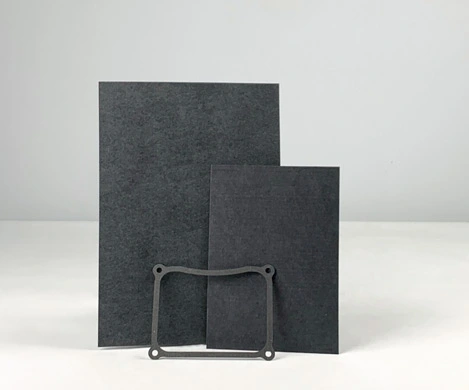The replacement of asbestos compressed sheet gaskets remains a technical challenge in the static sealing industry to this day. Currently, the mainstream countermeasures are to distinguish based on the working conditions: using metal and semi-metal gaskets in high temperature and high pressure situations, using fluororesin gaskets in corrosive environments, and using non-asbestos gasket material for general purposes. This article will briefly outline the current understanding of the use of non-asbestos gasket material.
Manufacturing Methods and Characteristics of Non-Asbestos Gasket Material
Non-asbestos gasket material is made by stamping and cutting sheets. Non-asbestos sheets are manufactured from a combination of various non-asbestos fibers, rubber binders, and other fillers. Based on the manufacturing methods, they are generally divided into calendered sheets and beater addtion material sheets.
Beater Addtition Non-Asbestos Sheets
The manufacturing process of non-asbestos calendered sheets is similar to that of papermaking. Fibers are turned into a slurry using a pulper and mixed evenly with synthetic rubber slurry such as NBR. The mixture is then formed into sheets by wet calendering using a wet machine (paper machine) and pressing with heated rollers.

Compressed Non-Asbestos Sheets
The process for compressed non asbestos gasket material starts with dissolving the rubber in a solvent, mixing in fibers and filling materials, and then blending the mixture into a clay-like substance using a mixer. The mixture is then pressed to a specified thickness using a roller press composed of a large diameter heated roller and a small diameter cold roller.
Reasonable Countermeasures for Using Non-Asbestos Gasket Material
Non-asbestos gasket material is significantly affected by high-temperature aging. However, their generality, low relaxation, low cost, and ease of use are also very evident. Researchers have found after several years of follow-up research that non-asbestos substitution is not simply about modifying the fiber component but requires the establishment of a new set of performance evaluation techniques for non-asbestos gasket material to correctly and comprehensively understand them.
We believe that it is necessary to continue researching and improving the formulation and processing methods of non-asbestos gasket material. In response to the problem of high-temperature hardening, we recommend the following countermeasures:

Control the usage temperature of non-asbestos gasket material. For machine applications where fastening management can be implemented in the factory, the usage temperature can be relaxed to around 200℃. For pressure pipelines constructed on-site, it is recommended to control the usage temperature below 150℃. In cases where additional fastening is required, the usage temperature should be controlled below 100℃;
When the temperature exceeds 100℃, it is recommended to use thinner gaskets (less than 1.5mm) with smaller stress relaxation;
During installation, apply a higher tightening surface pressure of 30-40MPa to avoid the need for additional tightening later;
Use gaskets in positions that are not prone to stress load on the piping or that are easy to replace;
Apply adhesive to the gaskets;
It is recommended to use ring gaskets that come into contact with the inner side of the bolts to provide sealing surface pressure.























